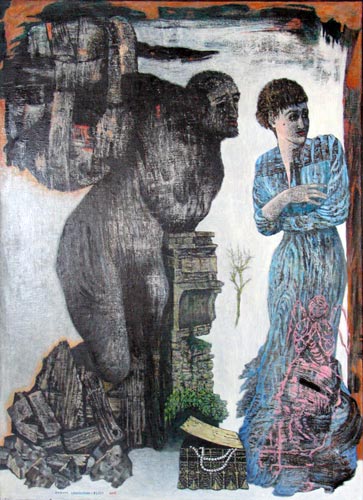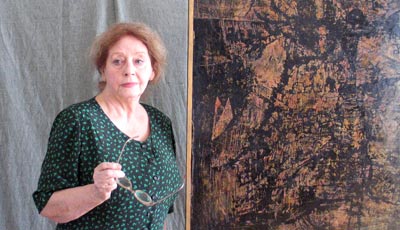










Fascynujące metafizyczne rebusy - tak określane bywają prace Danuty Leszczyńskiej-Kluzy. Malarka, związana z krakowskim środowiskiem artystycznym od czasu studiów w ASP pod kierunkiem Zbigniewa Pronaszki i Zygmunta Radnickiego, zdołała zachować niezależność, nie ulegając wpływom modnych kierunków i trendów. Wszechstronnie utalentowana mogła wybierać między malarstwem, muzyką i teatrem. Zdecydowała się na malarstwo, rysunek i grafikę - łącząc te dyscypliny dzięki zamiłowaniu do eksperymentowaniu z formą.
Najpłodniejszy okres w jej twórczości to lata 60., kiedy powstają znane cykle: Pustelnia - wielka opowieść o samotności i ascezie oraz Ogrody - poetycka i pełna aluzji pochwała życia szczęśliwego. Z lat 70. pochodzą m.in. oryginalne kompozycje dwumetrowej długości Zabić Ariadnę, Pallas i Dallas oraz Apollo (składające się z fotogramu i akwaforty na jedwabiu), a także tzw. "czarna seria", do której Artystka wykorzystuje fotografie siebie samej. Wtedy rozpoczyna też monumentalny, kontynuowany do dzisiaj malarski cykl "Universum" o tematyce egzystencjalnej. Intrygujące i efektowne prace Artystki prezentowane były na licznych wystawach indywidualnych i zbiorowych, m.in. tak prestiżowych, jak: Biennale Sztuki w São Paulo (1969) czy w Wenecji (1984).
Dzięki bogactwu skojarzeń literackich, historycznych i mitologicznych oraz finezji warsztatowej prac, wystawa "Malarstwo i grafika", która odbyła się w Muzeum Narodowym w Krakowie, w maju 2005, z pewnością sprawiła satysfakcję widzom zachęconym do poszukiwania ukrytych symboli i metafor.
 Danuta Leszczyńska-Kluza "Zeus i Zuzanna", 2002, olej/płótno, 134x97 cm |
Fascinating metaphical puzzels - that`s how Danuta Leszczynska-Kluza works have often been referred to. The painter, connected with the Cracovian artistic milieu since the time of her studies in the Cracow Academy of Fine Arts (under the guidance of Zbigniew Pronaszko and Zygmunt Radnicki), has managed to maintain her independence without succumbing to the influences of fashionable currents and trends. A versatile talent, she could opt for painting, music or theatre. She decided to practise painting, drawing and gaphic art, combining them as a result of her passion for formal experiments.
1960s were the most productive period in her artistic career, marked by such well - known cycles as: Hermitage - a great story about solitude and acetism, and Gardens - a poetic and allusive praise of happy existence. In turn 1970s saw - among others - the original two -metre-long compositions: To Kill Ariadne, Palllas and Dallas and Apollo ( cosisting of a photograph and etching on silk), as well as the socalled "black series", in which The Artist utilized her own pictures. At the same time she launched a monumental cycle of paintings on existential subjects called Universum, continued till now. The Artist`s works, intriguing and impressive, were put on show at numerous indywidual and collective exhibitions, among others, the prestigious Biennial of Art in Sao Paolo (1969) and Venice (1984).
Owing to the richness of literary, historical and mythollogical associations and workshop finesse of the Artist`s works, her last great exfibition "Painting and graphic art", shown in The National Museum in Cracow - Mai 2005 - were very satisfy for viewers, looking for hidden symbols and metaphors.
